Today, I’m going to tell you why I think you may need a semi-auto AR-style .308 rifle.
At least if you already have a good pistol and (possibly) an AR-15.
Look, the AR-15 is a GREAT rifle and it will get the job done for 99.9% of what you need. You can do everything from home defense at Close Quarters Battle (CQB) distances all the way out to making accurate, effective hits at 500 yards or even more depending on your skill.
That’s why I think it’s the perfect first or second gun to own. With a mid-size fighting pistol like a Glock 19 or S&W M&P (suitable for concealed carry) and an AR-15 you have almost all your bases covered.
Almost.
Why The .308 Is The Perfect “Next Rifle” To Get
The fact of the matter is that beyond 500 yards, while you CAN make effective hits with the AR-15, the 5.56 cartridge is starting to run out of steam.
What’s more: in states like my home-state of Virginia, they won’t even let you hunt deer with a standard AR-15 chambered in 5.56/.223.
(So much for the liberal narrative of the AR-15 being a “high powered” rifle!)
Finally, if your concept of use for your rifle in a SHTF situation is in the “sniper” role then while an AR-15 could work, the .308 may be a better choice.
The truth is for situations such as this, you should be looking at a slightly bigger cartridge.
And if you want something bigger than the standard AR-15 in 5.56, then I believe there’s no better caliber than the .308/7.62x51mm NATO.
Why Do I Think The .308 Is One of The Best All Around Rifle Choices
The fact is that the .308/7.62x51mm NATO is a great full-power rifle round. Here’s just a few reasons why …
1. It Has Excellent Terminal Ballistics. To quote the great DocGKR (emphasis mine):
“While snipers like to talk of head shots, there are an inordinate number of torso hits in the law enforcement forensic literature. As posted above, ASA indicates 47% of sniper shots were to the head (104/219), while 53% were to the body (115/219). As a result, law enforcement sniper bullets need to exhibit terminal performance which can consistently induce rapid incapacitation with shots to the torso, as well as the head. If you use a 5.56 mm, what happens when if you have to shoot through a window or into a vehicle, how about if the bad guy has something over his chest–perhaps AK mags? 5.56 mm is suddenly not looking so good:
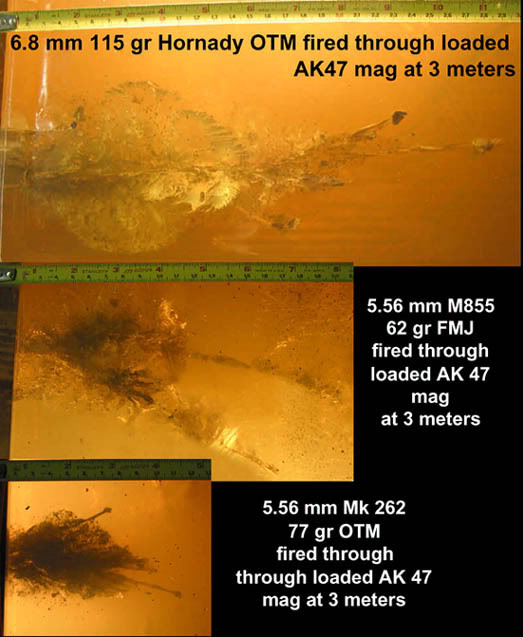
“Superior terminal effects and barrier penetration ability are why .308 dominates LE sniper use; .308 accounts for 74.5% (161/216) of sniper shots chronicled in the ASA data base.
2. It’s An Accurate Rifle Caliber
Here’s a bit of history that was new to me, from SniperCountry.com, comparing the .308’s inherent accuracy to the 30-06 (emphasis mine):
“… lets go back to when the .30-06 and .308 were the only cartridges allowed in NRA match rifle matches. Both cartridges were used in barrels of equal quality as well as the same action and stocks by several top shooters in the USA. Both cartridges were used in matches at ranges from 100 through 1000 yards. Many thousands of rounds were fired in both types. Bullets from 168 through 200 grains were used with several powder, case and primer combinations.
In comparing accuracy between the .308 and .30-06, folks who used each quickly agreed on one thing: .308s were two to three times more accurate than the .30-06. In the early 1960s, it was also observed that competitors with lower classifications using .308s were getting higher scores than higher classified folks using .30-06s; at all ranges. By the middle to late 1960s, all the top highpower shooters and virtually all the rest had switched to the .308. The Highpower Committee had received so many complaints of ties not being able to be broke between shooters using the .308 and shooting all their shots in the tie-breaking V-ring, something had to be done to resolve this issue. In 1966, the NRA cut in half the target scoring ring dimensions.
At the peak of the .30-06’s use as a competition cartridge, the most accurate rifles using it would shoot groups at 200 yards of about 2 inches, at 300 of about 3 inches. The 600-yard groups were 6 to 7 inches and at 1000 yards about 16 inches. As the high-scoring ring in targets was 3 inches at 200 and 300 yards, 12 inches at 600 and 20 inches at 1000, the top scores fired would have 90+ percent of the shots inside this V-ring.
Along came the 7.62mm NATO and its commercial version; the .308 Winchester. In the best rifles, 200 yard groups were about 3/4ths inch, at 300 about 1-1/2 inch. At 600 yards, groups were about 2-1/2 inch and at 1000 about 7 to 8 inches. It was not very long before the .30-06 round no longer won matches nor set any records; all it’s records were broken by the .308 by a considerable margin. Some accuracy tests at 600 yards with the .308 produced test groups in the 1 to 2 inch range. These were 20 to 40 shot groups. No .30-06 has ever come close to shooting that well.
At 1000 yards, where both the .30-06 and .308 were allowed in Palma matches, the .308 was the clear-cut most accurate of the two. If top shooters felt the .30-06 was a more accurate round, they would have used it – they didn’t. In fact by the early 1970s, the scoring ring dimensions on the 800 – 1000 yard target were also cut in about half due to the accuracy of both the .308 Win. over the .30-06 and the .30-.338 over the .300 H&H when used in long range matches.
Most top highpower shooters feel the main reason the .308 is much more accurate than the .30-06 is its shorter, fatter case promotes more uniform and gentle push on the bullet due to a higher loading density (less air space) and a more easily uniformly ignitable powder charge.
Military arsenals who produced match and service ammo in both 7.62mm and 30 caliber have fired thousands of test rounds/groups with both. They also found out that with both ammo types, the smallest groups were with the 7.62 by about 50 to 60 percent. M1 rifles in 7.62 shot about twice as small of groups as .30 M1s at all ranges. When the M14 was first used, there were some .30-06 M1 rifles that would shoot more accurately. It took the service teams several years to perfect the methods of making M14s shoot well, but when they did, they shot as good as M1s in 7.62.
There will always be folks who claim the .30-06 is a more accurate cartridge. All I have to say to them is to properly test .308 vs. .30-06 and find out. Theory is nice to think about; facts determine the truth.”
3. It Is A Very, VERY Popular Cartridge
The best thing, to me, about the .308 is that it is a super-popular caliber.
Look, I worry about things like gun grabbers in government making it hard to get ammunition … “Grid down” situations where it may be hard to get ammo … or even just scaring millions of americans so that ammunition becomes super expensive.
So I don’t want a ‘special snowflake’ caliber.
I’m not even that much of a gun collector or caliber collector. I like to stick to a few calibers and stack them deep so I know I have plenty of stores of ammunition for practice and if (God forbid!) the SHTF.
That’s why I like the NATO standard calibers. They’re VERY plentiful because they’re used by armies and governments all over the world. The 9mm, 5.56, and 7.62x51mm are all NATO rounds.
Combine that with an ample stash of 7.62×39 if you have an AK-pattern rifle and that means you have the same ammunition stores of all the world’s armies. In short, there’s almost ALWAYS going to be ammunition somewhere for you to use.
Sure I might be paranoid or whatever … but … something to think about.
Also, because it’s so popular there is plenty of commercial support. That means tons of different loads, bullets, weights, grains, etc are available for you to use.
Lastly, because it’s so popular, it’s a GREAT choice for hunting and will take down practically any medium to big game in North America. Nuff said on that as the .308 is a proven hunting round.
So if a .308 will do 80-90% of whatever any other “full power” rifle round will do, why not go with the most plentiful, popular, easy to find and commercially supported ammunition there is?
Why A Semi-Auto AR-Style .308 Over A Bolt Action .308?
Specifically, I don’t think there’s any better .308 — especially in semi-auto form — than the AR-style .308 rifle.
In fact, it was the original caliber that Eugene Stoner — the inventor of the AR-15 — used for his first “AR” rifle design while trying to win a military contract, called the AR-10. After not winning the contract, he later re-designed it as a smaller, lighter rifle in 5.56 NATO that we all know and love now as the AR-15
I’ll even go as far as to say that I believe the advent of reliable, accurate, ergonomic AR-style .308 semi-auto rifles make the bolt-action sniper rifle somewhat obsolete. At least in .308.
Why?
Because a semi-auto .308 is so much more versatile than a bolt-action .308 if we’re talking about self-defense or grid-down, SHTF type situations …
Even if all you had was ONE AR-308 rifle, then that one rifle could be put into use just like an AR-15 (at CQB distances, mid-range, large volume of suppressive fire, etc) and used for long-range “sniping” type roles too (a properly setup, quality AR-308 should easily produce MOA groups).
It’s that versatile.
If you’re talking precision, I just don’t see any real need for a rifle that would need to be more precise than .50-1 MOA in accuracy because most people can’t shoot that well anyways (unless it’s bench rested, perfect conditions, etc)
It seems like many of the U.S. Snipers over in “the sandbox” are moving in this direction too. Check out this short snippet of an article by Jon Weiler, a former Army Sniper and Precision Rifle Instructor (EDITOR NOTE: M110 SASS is a semi-auto AR-style .308 rifle (SASS stands for Semi-Automatic Sniper System) and the M24 SWS is a bolt-action .308 rifle (sometimes .338 Lapua) the SWS stands for Sniper Weapons System. Also, emphasis mine.)
“But which is better?
It all depends on the mission. We’re talking about the tactical usage of both platforms. The M110 SASS is now being used alongside the M24 SWS. I have spoke with snipers in different operating theaters about what their thoughts are on the two systems and I get mixed reviews about both. Some like the idea of the semi-automatic capabilities and some prefer the accuracy of the bolt guns. The reality of the situation is that these tools are designed for different uses. You can use a bolt gun in the urban environment – I’ve done it – but you will be much more effective with a semi-automatic rifle that is chambered in a caliber that has the sufficient distance and energy to drop the target. I would sacrifice accuracy for firepower in a MOUT Environment any day just because I know what it’s like to have to break contact with a team member having a bolt rifle as his primary weapon. Not practical and it can be a liability for the team. If a SASS system shoots to 1 MOA, you’re good to go anyways.
Practicality
To me, the practicality of the precision bolt rifle is better utilized in the larger cartridges, such as the .300 WM or .338 Lapua Magnum, at the ranges suited for them. There are some units that have been using the .300 WM in the Remington 700 platform for a few years now with excellent results. There is a push to upgrade the existing M24’s to .300 WM and I think it’s a good idea. It gives some extended range with the existing platforms, along with the proper terminal ballistics at those distances. In our military, there’s not the big usage of the .338 Lapua Magnum like there is in Europe especially. But I’m sure that that is on the horizon too.
Right now there exists the capabilities to scale up a semi-automatic platform to facilitate the pressures of each of these magnums – and I’m sure that manufacturers are working this now – but I would still choose the precision bolt rifle platform for these cartridges. It also depends on what the mission would be and the standoff distance. I don’t want to take the stance that this is the only application that I would use this platform for because it’s not. Everything is mission dependant. From my experience in Iraq, the semi-automatic fire proved to be more effective with multiple targets and combatants mixed with non-combatants. From my adjacent instructors in Afghanistan, the distances of the engagements would be more effective with the magnum calibers with more of a precision platform. But again, everything is mission dependant.
The Sniper motto, “One Shot, One Kill” isn’t always an accurate statement either. I’m sure that I’ve written about this before, but the reality of combat is that you never know what you’re going to do in a firefight or engagement, until you’re in one. But once you run a few missions, you fall into the motions and can work around these mental hang-ups. My point with that statement is that a weapon system with fast acquisition and follow-up is an important tool. This way, when you miss, you can adjust quickly and send that second shot before the target either can react or reach cover. So, the Semi-Automatic Platform works better for a target rich environment with varying targets at varying distances. The Precision Rifle works better to demoralize and harass the enemy from the extended distances with the larger calibers.”
Why An AR-308 Instead of an FAL, HK91, M1A, or SCAR17?
So if you are sold on a semi-auto .308 then you might think about other options other than an AR-platform. Here are the most common .308 “battle rifles” (to include their clones):
** FN-FAL
** HK91 (G3, PTR91, CETME)
** M14 (M1A)
** SCAR17
** AR-10 (308AR, too many variant names to list)
The AR-pattern, now called the AR-308 or 308AR, is the best choice over all these for many reasons.
One of the most important to me is weapons operations commonality. That is, all the training you do on an AR-15 (with much cheaper ammunition mind you!) will easily transfer over to the .308 because the ergonomics and mode of operation are the same for both.
Same loading procedure, immediate action procedure, safety use and location, similar triggers, and similar ergonomics …
Speaking of ergonomics, the AR-308 beats out all the others in this department too. Along with the easy customization you can do to fit your body and mission needs with the aftermarket stocks, grips, rails, handguards, etc
You could even have both your AR-15 and your AR-308 use the exact same furniture (buttstocks, etc) so they “feel” the same.
There’s also the issue of fitting a good optic system to your rifle. Except of the SCAR17, mounting optics on the FAL, HK91, and M1A is not easy as I understand it. With the AR-style rifle it’s as easy as mounting optics on an AR-15 (because, in fact, all AR-15 optics choices should fit!).
Lastly, the commercial AR-308 market has grown BIG time in the last couple years. They’re getting really popular so there are more manufacturers and more people making accessories for them too. That means it’s easy to find parts, if something breaks you can replace it easily, everything gets cheaper over time, etc
To me the AR-308 is a clear winner over the other semi-auto .308’s that are out there.
Why Not .300 Blackout, 6.8 SPC, Or Some Other “Upper” Or Special Caliber?
Really, for me, I thought about this, but it just doesn’t make sense at the current time.
First off, I go back to ammunition availability and price because I actually like to shoot my guns! There is a TON of the NATO stuff out there (9mm, .223, .308) and there is not a lot of commercially availablity of those other speciality calibers.
The stuff that IS available is expensive. At the time of this writing, it’s MORE expensive than the .308 ammunition!
So tell me why I would go with a smaller, less terminally effective, less hard-hitting round for more money per shot?
Doesn’t make any sense to me. If you reload and have the economies of scale worked out to where it saves you money to use one of these other calibers then I guess that makes sense.
But I don’t currently reload and I know I can buy .308 cheaper.
Another thing is the idea of switching uppers …
I would only need to use a .308 for some very limited roles. So when I want the .308, I would just grab the .308. Then I could also grab the AR-15 if I needed that. You could throw both in the truck and bug out and use the one you need at the right time, carrying more of the 5.56 ammo (because it’s lighter) for any high-volume shooting you need to do — and a limited amount of the .308 for the “sniper” stuff you have to do and you don’t have to worry about switching uppers (essentially disabling your rifle to be able to use it)
This Is The “Golden Age” of AR-308’s!
The truth is that for a long time, compared to the AR-15, the AR-10/AR-308 market was known for not producing very reliable rifles.
But in the last few years, that has really changed.
Now more and more manufacturers are coming out with .308 caliber rifles and they’re becoming more popular by the day.
Should You Get an AR-308?
Only you know if you may need one, but I think it’s a good choice if you want to round out your collection.
Again, I think an AR-15 in .223 and a mid-size CCW appropriate handgun like a Glock 19 are the perfect “first guns”, but that an AR-308 may be the perfect “next gun” if you want to do some mid-range to long-range shooting and move up to a heavier caliber for things like hunting.
What do you think?




![How Many Shots Will It Take? [Video]](/wp-content/uploads/2025/06/Depositphotos_2724272_S-218x150.jpg)





![What Level Holster Should You Be Using? [Video]](/wp-content/uploads/2024/04/Depositphotos_44548439_S-218x150.jpg)




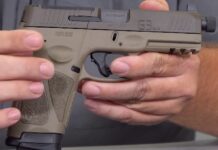


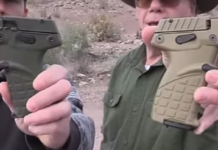


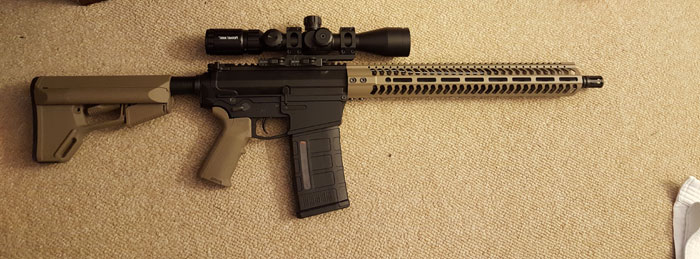
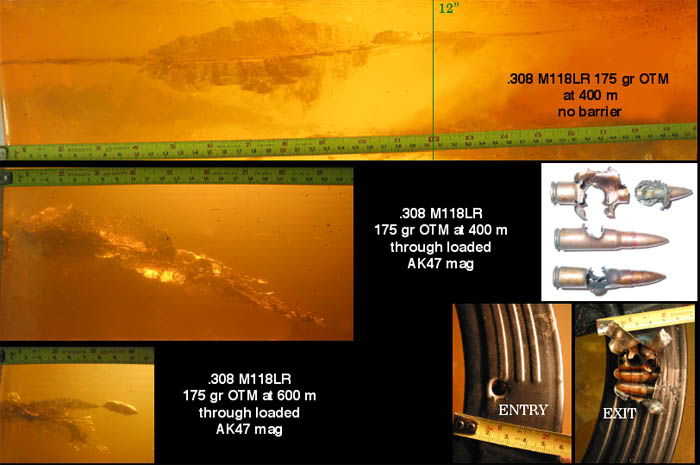










![Optic Ready vs Milled slides? [Video]](/wp-content/uploads/2024/02/image-3-100x70.png)
![[Checklist] What Gear You Need To Take Pistol, Rifle & Shotgun Training Courses [Video]](/wp-content/uploads/2023/07/Depositphotos_275087632_L-100x70.jpg)
![What is in Carter’s 2023 EDC? [Video]](/wp-content/uploads/2023/07/Depositphotos_146856137_L-100x70.jpg)



I have always said that the 308 150 grain silvertip remington core lokt load was my most accurate load for deer hunting.My father has killed a few deer out to 1000 yds.In the 1960s with that same load and in a 742 Remington semiAuo. With that said I believe a semi Auto AR-15 in the Nato shell will replace the weaponry that the Government has now. I have both 762;39 and the 9mm. 5.56 but the governmant is leaning on the 762;51 and with the problems we have in our governmant now if you need ammo later on to defend yourself in a combat situation it will be in your favor to go along restocking your ammo as you free yourself from one zone to the next as you clear your objectives and scarf up the fatalities fallen ammo reserves ! The 762.39 ammo is 5bucks a box in the wolf brand at Dhunums and comes in 123 and 124 soft point and FMJ.It makes a nice shooting inexpensive ammo to shoot.
I currently use a 762;39 semi auto and the ammo is cheap in the russian load which is plentiful everywhere.You can get lead rounds in Wlof brand at Dhunums for 6.00 a box in 123 and 124 HPs or 124 FMJ it is a great way to shoot cheep. The 308 has been my best ammo round in the 150 gr,silvertip which has killed deer ot to 1000 yards even as far back as the 1960s ,
I just bought a Patriot Ordinance Factory AR in .308.
Awesome I’m waiting and saving for one of those myself I wish they’d make one with the 18″ barrel again though as that would be near perfect. 16″ revolution I will be if they can release it by the election. If not p308 16″ cerakoted
I bought 2 POOR OLD FARMERS POF and got rid of both of them. They jammed to much,sent them to POF for repair got them back and sold them.
I’ve been a big fan of the .308 for years. Been shooting one in my deer hunting since the early 80s, the same gun. Still own it. It’s still my go to gun for hogs and general shooting. My only possible point of contention with the article is the recommendation of the AR platform, or any semi-auto, ever a bolt action. That old bolt action model 788 has performed well for a long time, never giving any trouble if I do my part. A semi-auto, with so many parts, is not likely to hold up that well over that long a time.
However, this is not to say that the bolt is ALWAYS the better choice. In a firefight situation, the semi-auto wins hands down. Follow up shots, multiple targets, you name it, and the long life of the bolt action will do you no good if you don’t survive the firefight. The sniper shooting a single shot is all fine and good, but the capability to carry one gun for everything one might encounter in a SHTF situation makes the AR platform very attractive.
Most of the AR 308s I’ve encountered weigh substantially more than an AR15, and that’s actually helpful in taming the .308s more robust recoil. You just gotta carry that thing, and it can be a load. Ammo load out is also a weight concern.
My biggest complaint about an AR in any caliber is the amount of drop built into the stock, I have a rather long neck, and getting down behind the scope on some ARs is troublesome. It can be done, with higher rings and bases, but that brings on it’s own complications, especially if you’re using one gun in close and far out.
okay I read all of this but I did not SEE how to build a AR-10 .308.
I have an M1A with a barrel from a commercial maker and glass bedding and a 4x scope and it is plenty accurate and easy to operate and a lot easier to maintain than my M15 which to me is is entirely too complicated. I couldn’t believe how much trouble it is to just clean that rifle compared to the M14/ M1A. The bolt on the M15 is like a piece of scrap metal with no weight to it at all. The weapon feels cheap even though it is made by a reputable company. My M1A is just like the one I carried in the service and I can field strip it in about 15 seconds. Takes me about 3 minutes to field strip the M15. And you can forget about vertical butt stroke and hold with the M15. The M1A can serve quite nicely as a close quarter bludgeon.
As a youth I shot at Camp Perry with my Dad. I started off with an M-1 garand 30/06 then a model 70 Winchester 30/06. There was a considerable amount of difference between the two. But, then we purchased a Winchester Model 70 .308 and it was even better. My dad explained some of the difference had to do with the travel of the bullet. The .308 had a flatter trajectory over the 30/06. If you looked at the scores at Camp Perry the .308’s were doing a much better job. The last year I shot there I checked out an M-14 national match and I absolutely loved it. To this day I prefer that rifle if I could afford one. All of you 2 amendment supporters, keep up the great work and get your concealed carry permit. The only way that we will take back America is like the old west. Everyone needs to carry so that the terrorists are not sure who that they are dealing with. Good luck, Good hunting and God Bless America….
Well, I don’t agree. While it is only my experience that I draw from, it is that experience which forms my opinion… I have found 30-06 ammunition more frequently available, especially in the more isolated locations, than any other rifle caliber other than perhaps 30-30. With the popularity of .308 and the fact that its a NATO round, that may change the availability difference in the future. I’ve found that when shooting heavier rounds, ie; 180-220 grain projectiles, especially flat, or round nose bullets, that the 30-06 carries farther and hits harder than the .308… especially against larger and thicker-skinned animals such as bear, elk and moose. I wouldn’t think of using a .308 on any large bear or moose. Maybe I’m old school, but I’ll reach past a .308 for an old 30-06 every time…
Comments are closed.